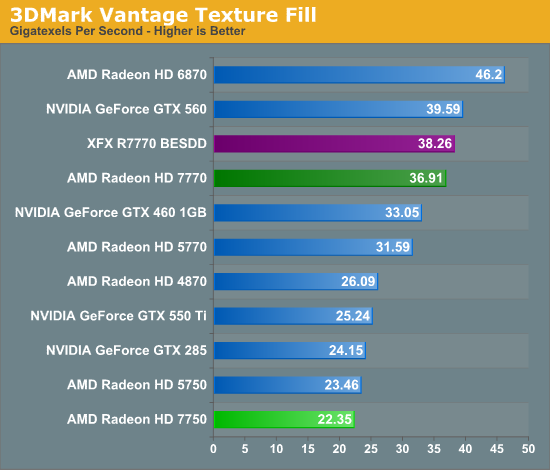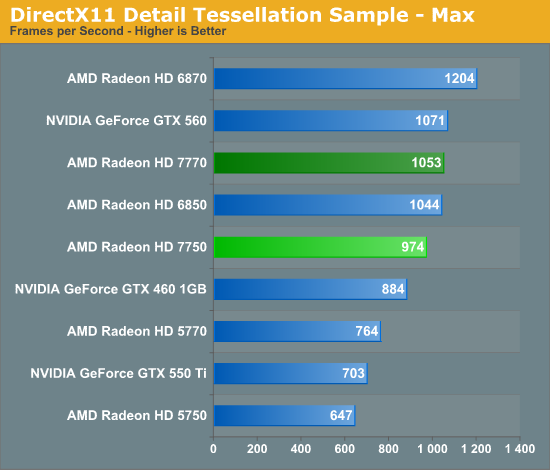AMD Radeon HD 7750 & Radeon HD 7770 GHz Edition Review: Evading The Price/Performance Curve
by Ryan Smith & Ganesh T S on February 15, 2012 12:01 AM EST- Posted in
- GPUs
- AMD
- HTPC
- GCN
- Radeon HD 7000
Theoretical Performance
Before moving on from compute performance, we wanted to quickly take a look at theoretical performance. Identifying the theoretical performance of the 7700 series in relation to other cards may help explain why it’s often trailing the 5770 and 6850.


A quick look at texture fillrates gives us our answer for the 7750: it has even lower texture performance than the 5750, never mind the 5770. Thankfully very few games are heavily texture bound these days – and if they were the 7750 likely wouldn’t have enough VRAM for them anyhow – but the massive gap in theoretical texture performance between the 7750 and7700 means that the 7750 is behind virtually everything else.
Conversely if you look at the pixel fill rate it’s almost identical to the 7770, which in turn trails the 5770. However in this case the 3DMark Pixel Fill test appears to be heavily memory bandwidth bound, which is why it trails the 6870 by so much.

Moving on, looking at tessellation performance is both good and bad for the 7700 series. With a maximum of 1 triangle/clock, GCN’s tessellation improvements can only do so much. It’s enough to vault past the 5770, but the 6870 still has better tessellation performance even with its lower clockspeed. Given AMD’s use of off-die buffering, it’s entirely possible we’re looking at a memory bandwidth constraint here.

Unigine Heaven backs these findings and then some. Tessellation performance is improved relative to the 5700 series, but at best the 7700 series is only going to catch the 6850.










155 Comments
View All Comments
PatrickSteamboat - Wednesday, February 15, 2012 - link
Will there be any testing on Cape Verde's Crossfire scalability in the near future? I'm really interested to see if dual 7750s can fill the gap between it and the 6950. Unlocking a hidden, low power 6900 variant, the missing 6930, without having to match and compare more than three SKUs sounds too good to be true.Roland00Address - Wednesday, February 15, 2012 - link
7750s can't do crossfire since they do not have a crossfire bridge.7770s can do crossfire since they have a single crossfire bridge (can't do trifire though).
PatrickSteamboat - Thursday, February 16, 2012 - link
Can't believe I missed... anyways, thanks for that.
I found a preliminary benchmark with dual 7770s. Numbers look great so far, but at $318 for two, I'll be waiting until I can have both for less than $279. One now @MSRP, the second discounted once Kepler is out.
mczak - Thursday, February 16, 2012 - link
That isn't true. 7750 don't have a crossfire connector but they can do crossfire just fine, by transferring the data over the pcie bus.According to techpowerup benchmarks which tested that there's not even really a performance hit due to that (though they used a board with 2x16 pcie lanes, albeit only pcie 2.0, so should be similar to ivy bridge lga1155 which will have 2x8 pcie 3.0, and it might be worse on sandy bridge lga1155 which only has 2x8 pcie 2.0), though they say there were some stability issues, which certainly are driver fixable.
I usually question the viability of low-end CF setups however, I think you'd be far better off with one HD7800 card instead (you shouldn't need to wait that long for it after all).
Belard - Thursday, February 16, 2012 - link
Its been almost 4 years since the ATI 4850 was released. Within about 6~8 months of being on the market, it became a $100~110 card.The NEW 7750 is also a $100~110 and from looking at these reviews, it performs no better than a four year old gaming card that sold for $100.
Menoetios - Thursday, February 16, 2012 - link
Nvidia is as much to blame for the lack of shift in the price/performance curve as AMD. That's just the nature of competition. If you look at the 7770 and 7750 pricing compared to what Nvidia currently has available, it falls right in line. AMD doesn't care that you buy a 7770 or a 6850; with the former they'll make a nice margin, with the latter it'll help clear out the channel. They only care that you buy one of their products, and their products are priced just fine to that end. With only 123 mm2 die size (it's quite tiny), the 77** cards have a lot of room to get cheaper when Kepler is released. And I hope Kepler is REALLY good, because that's when we'll see the true price/performance shift.chizow - Thursday, February 16, 2012 - link
How so? Nvidia is not the one pricing their next-gen parts based on last-gen performance and pricing, AMD is. If Nvidia does that with Kepler, then you they share in equal blame. But AMD had the chance to fire the first salvo this generation and they whiffed, badly, on all 3 volleys now (7970, 7950 and now 7770).Menoetios - Thursday, February 16, 2012 - link
AMD have set their prices according to what's available on the market from Nvidia.chizow - Friday, February 17, 2012 - link
And that's exactly the problem! They're pricing new 28nm next-gen parts based on old 40nm last-gen price and performance levels. Nvidia's pricing was justified 14 months ago because the performance was there. It would not be satisfactory if they came out with a "new" part tomorrow and priced it the same as their old parts, would it?Blame lies squarely on AMD for this because they set the pricing on their parts and they were first to market. Look at it historically over the last 2-3 major generations, never once has Nvidia done this with a new architecture (not refresh) in terms of moving the performance bar so little while expecting the same top of the line premium pricing.
Hellbinder - Thursday, February 16, 2012 - link
Ok, Anand continues to amaze.. he/they are either dumber than a box of rocks or intentionally biased against AMD and simply looking for any excuse to skewer them. Personally i lean towards option number 1.The author of this review has completely buffooned the entire thing by getting the basic workings of AMD numbering & performance scaling WRONG.
yes the naming convention changed. but not in the way anand seems to think. This should be no brainier information for a site like this.
Top 7900 next 7800 next 7700 next 7500 next 7400 and so on.
The 6000 series was identical
Top 6800 next 6800 next 6700 next 6500 next 6400 and so on
the older models were different.
IF you want to compare apples to apples you compare the 6700 series to this series. The 6800 series is an entire tier above this card and should outperform it.
This site needs to get its crap together because nearly every other tech site makes this one look foolish, because they are foolish. or fire this reviewer and the editor and get some people who know what the hell they are talking about.